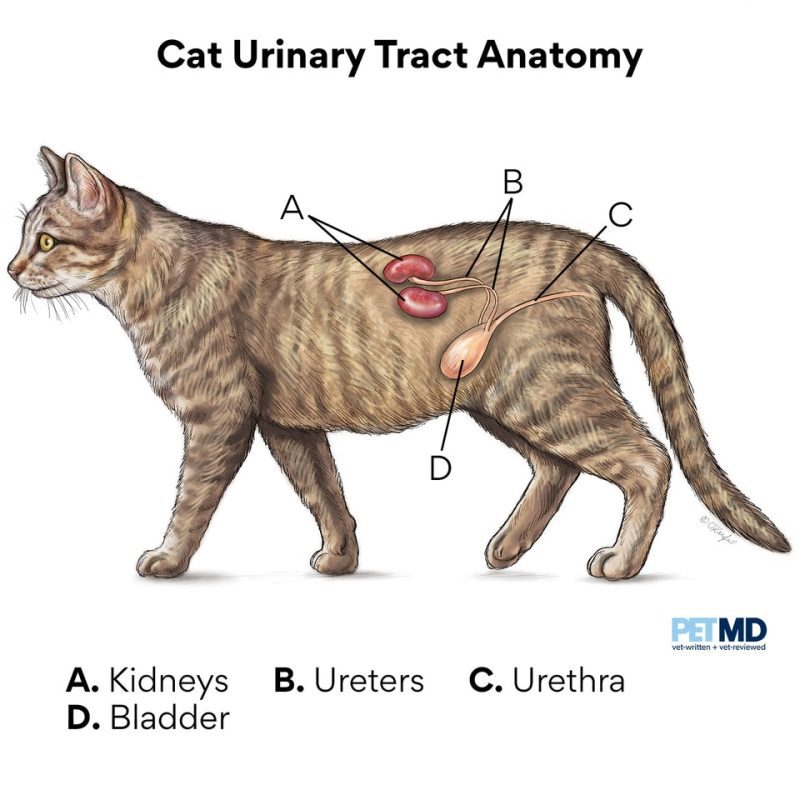
Cats get sick too: problems of the genitourinary system, and why the cat can’t pee
Most people associate the appearance of domestic cats with Ancient Egypt. The religion of the Egyptians also contributed to domestication. Cats were symbols of fertility, and everyone, without exception, worshiped them. It happened about 10 thousand years ago. But scientists have established that the domestic cat descended from the steppe, which lived not in Egypt, but in Nubia. Consequently, there is still no consensus on the origin of domestic cats. There are disputes about the process of domestication itself. Did man do this on purpose to protect crops and food from rodents? Or did wild cats themselves follow people, hunting crop pests along the way?
In Europe, cats from Nubia interbred with local European individuals, and this led to a wide variety of breeds. Residents of Italy, Switzerland, Germany actively accepted cats into their homes, hoping to save the crop.
But until now, domestication cannot be called completely completed. Although cats are common pets, their headstrong nature proves that they will never be completely submissive. And their whole life next to a person is just a great gift for people.
Contents
Physiology
The average cat reaches length 60 cm without tail, and the tail is about 30 cm. Sexual dimorphism is implicitly expressed, individuals differ only in their size. Females are smaller than males. The largest cat, the record holder, has grown in length by 122 cm.
The weight of adult cats does not exceed 6 kg, but there are also large specimens gaining up to 10 kg. The record holder in weight was heavier than 20kg. For cats, being overweight by more than 2kg is already a sign of obesity.
The skull of a cat is distinguished by large eye sockets and developed jaws, which is typical for predators. The jaw has 26 teeth and 4 fangs, which are designed for killing and tearing flesh. The cat catches the prey and bites it, plunging its fangs into the victim’s spinal cord. This leads to very fast death.
cat hair electrifies when rubbed, so when combing, either the wool or the brush should be moistened. Also, the accumulation of static electricity occurs when the air is too dry, in such a situation, you need to use a humidifier.
The cat’s body temperature should be between 38-39 °C.
senses
According to many scientists, cats have the most developed sense organs than all other mammals. However their hearing is much weakerthan in mice. But they can boast of vision, smell, tactile and taste buds.
- Hearing
Cats have directional hearing – they sort all noise according to direction. The auricle of the animal moves towards the source of the sound. Two auricles can move simultaneously in different directions, catching several sources at once. Cats can recognize the strength of a sound, its height and distance, as accurately as possible by establishing the location of the source of the noise. This sense organ is so well developed that the animal, even with its eyes closed, can catch running mice.
- Vision
They have very large, forward-facing eyes. That is why they have stereoscopic vision, thanks to which they determine the distance to visible objects. The field of view is 200° (in humans – 180°). Because cats are nocturnal predators, they can see just as well in low light as they do in daylight. In absolute darkness, cats do not see, and in bright light, their vision becomes worse than human.
Contrary to popular belief, cats can distinguish colors. Only they see them not as contrastingly and brightly as people. It has been noted that cats that are stationary and nearby see worse than moving ones. They can focus vision 2 times worse than a person.
- Touch
The tactile functions in cats are carried out by whiskers (vibrissae) located on the muzzle. The hair on the tail, on the inside of the limbs, on the tips of the ears and in the ears have the same function. This hair should never be cut. By the vibrissae, one can distinguish the mood of the animal: during aggression, the mustache is pressed to the muzzle, and the mustache directed forward speaks of curiosity.
- Smell
A highly developed sense organ. A cat’s sense of smell is 14 times stronger than a human’s! In the upper part of the oral cavity, they have a special organ that helps to distinguish particularly subtle odors. To do this, the cat opens its mouth, making a grimace.
- Taste buds
Cats can easily distinguish between sour, sweet, salty and bitter. They have such intelligibility because of the well-developed sense of smell and taste buds on the tongue.
- Vestibular apparatus
Everyone is well aware of the superbly developed feline sense of balance. After all, cats with enviable speed and ease move along fences, trees and roofs. When falling, cats quickly group and fall on their paws. The tail and reflexes help them in this. The paws spread out to the sides create the effect of a parachute. But this does not guarantee the survival of a cat when falling from a great height, because. at this point, the animal experiences a severe shock. However, low altitude is no less dangerous – the animal simply does not have time to regroup and may die.
Reproduction
Cats go into heat several times a year. If fertilization did not occur at the time of estrus, she repeats in 2-3 weeks. Cats mark their territory during mating season. The period when the cat is ready for mating lasts no longer than a week. These days, the cat rubs its muzzle, meows loudly, “beckoning” the cat.
Pregnancy lasts about 2 months. There are 3-8 kittens in one litter, which are born blind, bald and deaf. After 2 months, the kittens are already beginning to eat meat.
Cats are considered to be exemplary mothers, but sick and weak kittens they throw. Cats often, along with cats, raise offspring and protect them. In the event of the death of the mother, the fathers can take care of everything.
cat health
There is an opinion that a cat has nine lives and that these animals are amazingly tenacious. And many mistakenly believe that a cat should heal itself from any disease. This is a very dangerous delusion. Cats are living creatures that are prone to colds, inflammation, and obesity.
A very common reason that makes people go to the veterinarian is “the cat can’t pee.”
If you notice any of your pet’s urination problemscontact a specialist immediately! Do not try to identify the disease and treat it yourself. And even more so, do not force the cat to write!
No matter how hard you try to provide comfort, care and proper nutrition to your cat, no one is immune from diseases. And if your pet has a problem with going to the toilet, this is the first sign of urolithiasis. In such a situation, medical intervention is indispensable, otherwise death is inevitable. Sterilized cats are primarily at risk of urolithiasis.
There are signs, which help to detect problems with the genitourinary system before you notice that the cat is not pissing normally. It:
- the presence of blood in the urine;
- bloating;
- frequent urination.
If the animal cannot pee
The cat starts acting strange. It meows loudly and spins in circles near the tray. When urinating, the animal experiences pain, therefore, most likely, it will cling to the edge of the tray. Only a specialist can accurately determine the reason that a cat does not pee as usual. Therefore, in no case do not postpone a visit to the veterinary clinic.
Difficulties with urination could mean kidney problems. In this case, the cat may not have the urge to go to the potty at all.
Inflammatory processes in the bladder or urethra can also prevent the cat from peeing. Whatever it is, a visit to the vet is essential. The doctor will examine your pet, prescribe tests that will help determine the diagnosis. And if you delay the solution of this problem, urine in the bladder will accumulate and this can lead to inflammation of the kidneys and even to the rupture of the bladder.
The most dangerous thing in such a disease is complete blockage of the urethra, then the cat cannot write at all. In such a situation, the animal is frightened, hides, stops eating, and his temperature rises. If it is not possible to immediately go to the veterinary clinic, you should put a warm heating pad on the cat’s stomach. Do not massage under any circumstances! This will damage the bladder. All this will come down as an emergency. If within three days you do not go to the veterinarian, there will be intoxication of the entire body of the animal.
At the hospital, the veterinarian will give the cat pain medication, put in a catheter, and do an ultrasound to determine the size of the stones.
How to prevent diseases of the genitourinary system
Proper balanced nutrition. Read the ingredients before buying food. Good food should not contain a lot of minerals. Try to enrich your pet’s diet with vitamins B, B 6, A and glutamic acid. Try not to give salty and raw.
Urolithiasis is not completely cured. Only constant preventive measures, regular visits to the veterinarian, taking diuretics and antibiotics are carried out. All this will contribute to the return of your cat to normal life.





